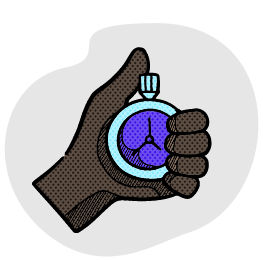
The path to finding your dream job is different now than it was a few years ago. It is much harder.
With uncertainty in the economy and job market, the talent pool for work becoming global, and new technologies emerging like AI, the job market has never been more competitive.
I run a consulting business where I help other business owners sign clients. A good number of these business owners happen to be career coaches who help people find jobs.
After working with a dozen of them in different niches, industries, and sectors, I’ve noticed patterns. Over time, I’ve learned effective mindsets and techniques for the job search process—just by observing the work my clients do with their clients.
I’m sharing these top insights to help you find your dream job (and get the offer). Let’s get into it.
The mindset required to land your dream job in 2025
The social contract has been broken between society, employers, and job seekers.
Here’s how the process used to work:
- Go to school, get good grades, and graduate from university
- Mass apply to jobs that fit your criteria
- At some point, you’ll land a good job
It was like having the right kind of degree essentially guaranteed you a job.
This was especially true in STEM fields. A decade ago, if you were a software engineer from a good school, getting a high five-figure entry level job and ascending into a six-figure role was pretty guaranteed.
Now? You have to be creative when it comes to your job search.
One of my clients is a data scientist who worked at Meta. From what she tells me, students who are just graduating from school from software engineering are having a much tougher time (as opposed to people who already have work experience).
And even her clients and people in her audience who do have experience, discouraging stories are common. Folks applying to hundreds of jobs and barely getting any interest from recruiters or hiring managers.
Here’s where mindset comes in.
You can either have an entitlement mindset or an ownership mindset. These concepts come from one of my clients who is an ex-recruiter turned career coach.
This is the most important distinction I’ve observed during my career coaching clients, and it’s the difference between people who eventually land their dream job and those who stay stuck in frustration for months or even years.
The entitlement mindset
- “My skills and experience will speak for themselves.” A lot of people feel entitled to a job just because they have a degree and experience and they’re upset that this is no longer enough.
- Expecting the market to reward you without adaptation. The ‘spray and pray’ model of mass applying to jobs on places like Indeed and LinkedIn doesn’t work well anymore and some people refuse to pivot.
- Defaulting to complaints when results don’t come. I spend a lot of time on LinkedIn and I’ve noticed a ton of complaining about the market, but complaining isn’t a viable strategy. I even wrote a post about it on my page.
They’re not wrong about the system being broken. But complaining about it doesn’t get you hired. And doing it publicly online makes you even less likely to get your dream job.
Job seekers who fail to land the job focus on the way things should work, and this sums up the entitlement mindset.
In contrast, the ownership mindset starts with fully accepting that the market has changed, and you must change with it.
The ownership mindset
- “What do I need to change to get the result I want?” Even in a competitive market, people are getting hired. Many are trying different strategies to get ahead. So it makes sense to reverse engineer how they did it to get a similar result.
- Embracing strategy: Being qualified isn’t enough. You have to understand how to package and position your experience in a way that attracts attention and opportunities from recruiters, hiring managers, and companies.
- Accepting the humbling process. Smart, skilled, and successful people often struggle with the idea of humbling themselves, because they have to (in a way) start over with a “beginners mindset.” Hard to teach an old dog new tricks, right? But it may be the only way.
I’ve seen the ownership mindset work out well for dozens of the clients who have worked with these coaches. I’ve seen case studies and results, where they land dream jobs that pay six figures, often time at prestigious FAANG companies.
Those with the ownership mindset come to the realization that what they’ve tried isn’t working and it’s time for a change. This is why many of them hire coaches like my clients and get the exact result they wanted—their dream job.
Now let’s take a look at some of the specific strategies I’ve learned from my clients that you can apply to your own job search.
You have six seconds to catch their eye
That number comes directly from a former recruiter who has looked at thousands of resumes.
You have a couple of seconds to grab attention and that’s it. It is what it is.
You always want to think:
What’s in it for them?
If you’re trying to get a job, it makes sense to get inside the minds of recruiters and hiring managers.
One of the biggest job seeker mistakes is only thinking about themselves. Their resumes look like a long, bloated, and boring list of basic tasks they performed at their job.
But if you get inside the minds of the people trying to hire you, you have the keys to writing a resume that stands out.
Here are my best tips, with quotes straight from my career coaching clients.
Focus on impact, not tasks
Achievement-oriented bullets are focusing on the impact of what you did. So instead of listing a responsibility or a task you were in charge of, or saying “I did this,” you’re saying “I achieved this.” You start with the impact of your work, and then explain how you did it.
People often write their experience like this:
This tells nobody anything. It’s generic, forgettable, and could apply to thousands of other people.
Someone with an ownership mindset would rewrite that same role:
See the difference? The second version tells a story of transformation and impact, which is what recruiters, hiring managers, and customers want to see.
When you don’t have numbers, do this
If you don’t have [concrete numbers for business growth] that’s okay. You can think about it in other terms. How many groups did you work with? Cross functionally? How many members were on your team that you oversaw? What number of projects did you work on in a span of time? Any time-based numbers whatsoever.
If numbers aren’t possible, focus on outcomes:
You can leave a number out, but make sure you’re talking about the specific impact and how you did it. Make sure you’re leading with value.
Keep it clean and readable
Less is more. Clarity and readability matter most.
Most resumes fail because they’re “overly dense—walls of text, no breathing room” or they “try to sound overly smart—too many buzzwords/filler.”
The worst resumes fall into two categories: “Too little effort: vague, generic bullet points” or “Too much effort: every detail crammed in, hard to read.”
Try the Transformation Story Framework
Start with the situation you inherited, describe the actions you took, and highlight the results you achieved. Think of each bullet point as a mini case study that proves you can deliver value.
Stories are always the best way to get information across to other human beings. It has been the main vehicle to pass information from one person to another since the dawn of time. The best marketers use storytelling to sell their products. Use storytelling to sell yourself.
Leverage this platform to have a shot at your dream job
All of my career coaching clients are active on LinkedIn. That’s where job seekers hang out and that’s where recruiters and hiring managers look for candidates.
Everybody knows they should be on LinkedIn.
And typically, everyone looking for a job does have a LinkedIn.
But most job seekers don’t know how to use LinkedIn effectively, and they are criminally underutilizing their profiles.
👆🏾This is one of the biggest insights I’ve learned from all of my career coaching clients.
If you want to land your dream job in 2025, steal from the playbook that content creators use to get attention.
If you go to the page of someone who is consistently creating content, like someone who is using content to get coaching clients, here’s what you’ll notice on their page:
Talk about outcomes in your bio and banner
Here’s a bio from one my clients:
Notice a few things about the bio:
- It has the words “career coach” in it, which optimizes for search
- It follows the classic I help [target audience] achieve [outcome] format
- “Former recruiters & hiring leader” gives her a unique edge and angle as a career coach
- 15+ years of not just regular knowledge, but “insider knowledge” she gained from being on the other side of the process
Here’s a banner image from one of my clients:
Notice how it clearly speaks to the outcome you’d get from working with her?
You can do the same thing as a job seeker.
Instead of only using your job title in the bio and nothing else, with zero banner image, you can steal this framework. Change your boring and drab LinkedIn page into a clever, creative, and compelling one.
My clients help their clients write bios using the “I help [target company type] achieve [outcome]” statements in ways that tie to the business goals of their target companies.
Bio examples:
Try: “I help tech startups launch products on time and under budget using proven agile methodologies” Instead of: “UX Designer passionate about user experience” Try: “I help mobile apps improve user engagement through research-backed interface design and usability testing” Instead of: “Marketing Manager seeking new opportunities” Try: “I help B2B SaaS companies generate qualified leads through data-driven content and campaign strategies”
Having a solid bio and banner image are sort of basic and well-known tactics in the creator world, but they’re new and revolutionary in the job seeker world. Use them to your advantage.
Develop your personal brand (it’s no longer optional)
There’s a saying: “Every company is a media company.”
These days, it’s impossible to not have an online presence. Every company has one. Some do a great job of presenting themselves online and others neglect it completely, which simply means they have a low-quality online presence.
The same idea applies to individuals in 2025:
Every person has a personal brand.
Even if you don’t actively maintain a brand, anyone—other people, companies, recruiting managers—can easily look you up online. Now, imagine you google two different job candidates.
When you search for Candidate A, you find a barren LinkedIn profile and that’s it.
When you search for Candidate B you find:
- A personal blog with a library of content sharing their insights from the field
- A LinkedIn page with weekly posts demonstrating their competence, showcasing their skills, and keeping up with trends
- A portfolio site with case studies, experiments, and past projects
Who are you more likely to hire?
Also, Candidate B probably doesn’t need to spam apply for jobs because they’re likely attracting inbound opportunities—meaning they’re so good at what they do, and they have the ability to showcase it, that dream jobs are coming to them.
Here are some basic tips to get started:
- Pick one or two platforms and stick with it: LinkedIn is obvious since recruiters live there, but others could be valuable, depending on your industry or role. Don’t spread yourself thin across multiple platforms.
- Commit to a realistic posting schedule: Once a week beats daily posting for two weeks and then disappearing.
- Start with what you already know: Share insights from projects you’ve worked on rather than researching new topics overnight.
- Keep it simple: A 200-word LinkedIn post can be just as effective as a 2,000-word blog post.
- Document, don’t create: Instead of creating content from scratch, document what you’re already doing.
- Engage with others in your field: Comment thoughtfully on industry leaders’ posts to build relationships without creating original content every time.
- Don’t worry about being perfect: Your first posts won’t be amazing, but you’ll improve as you build a track record. Progress not perfection.
How to apply for your dream job
I remember being in college and watching my friends graduate (I ended up dropping out).
There was something I noticed that kind of baffled me.
After spending four years working hard to get their degrees, they would just spam apply to jobs and take whatever they could get.
There was no real intention or strategy behind it—just a massive volume of applications and crossing their fingers.
Even though it wasn’t the path to purpose and passion, it worked. Nearly all of them would land somewhere and land somewhere comfortable.
But this no longer seems to be the case.
Yes, you still have to apply to a lot of jobs, but it makes sense to have a much more targeted approach if you want to land your dream job.
Take the time to figure out, you know, what kind of job you actually want:
- What’s your ideal salary?
- What kind of work environment do you want to have?
- What values are important to you?
- What kind of projects would you like to work on in your field?
- What role gives you the ability to follow your intellectual curiosity?
- Do you want to work remote or in person?
Getting clear about what you want, not just when it comes to landing your dream job, but pursuing any goal, has a way of making the right opportunity present itself. What you focus on expands.
Now that you have your dream role in mind, it’s time to start seeking out the right companies and applying strategically.
Build your target list (instead of throwing darts blindfolded)
Build a list of 10-15 target companies you really want to work with.
This isn’t complicated, but most people won’t do it because it requires actual thought.
Start with companies you’ve heard of and respect. Then dig deeper. Look up their competitors. Check out “People Also Viewed” sections on LinkedIn company pages. Once you have your list, become a stalker. The good kind.
Follow their social media. If the company page posts content, like and comment on it. If individuals at the company post on their social media, like and comment on their posts as well. Endorse their skills. Send them a thoughtful DM (more on this later).
When you do all of the above, do it with thought and intention. Rule of thumb for leaving comments: You are not allowed to say “great post!” or “congratulations!” You have to go deeper than that.
If you build a targeted list like this, when you post jobs, you won’t be some random applicant. You’ll be someone who’s been paying attention. And if your name has been all over their feeds, it’ll catch someone’s eye when your resume hits their inbox.
Words directly from one of my clients:
Long-term goal = building visibility and relationships at target companies, so that when a position opens up they think of you.
Do your homework before you apply
Here’s where most people screw up. They see a job posting and immediately start customizing their resume. Wrong order.
First, research the hell out of the company. What problems are they trying to solve? What initiatives did they announce recently? Who would be your boss? What’s their background?
Dig deeper: Reference older blog posts or less obvious company news.
Spend 20 minutes on this. Look beyond their main website. Check recent press releases. Read their quarterly reports if they’re public. Find out what their employees are posting about on LinkedIn.
This research serves two purposes: It helps you figure out if you actually want to work there, and it gives you ammunition to customize your application in a way that shows you’ve done your homework.
Make your application materials work together
Your resume, cover letter, and LinkedIn need to tell the same story. Most people treat them like separate documents thrown together at the last minute.
Think of it like a legal case. Your resume is the evidence. Your cover letter makes the argument. Your LinkedIn provides supporting documentation.
If I can take your cover letter, swap out the company name, and use it for a different application without changing anything else, you’ve failed.
Track everything like your dream job depends on it (because it does)
Staying organized and consistent helps you use your energy wisely, not burn out, and focus on the process vs. getting paralyzed by rejections that will inevitably happen.
Most people apply to jobs and then… forget. They can’t remember where they applied, when they applied to, or who they know at different companies.
Build a spreadsheet. Track every application. Note the date you applied, the job title, who referred you, and what happened. When you get rejected (and you will), you’ll have data to analyze instead of only feelings to sulk about.
If you want to get a job, treat your job search like the business operation it actually is.
Practice this daily habit (that actually works)
Here’s the difference between people who find jobs and people who complain about the job market:
Best clients: ~2 hours/day networking and applying. Average job seekers: <30 mins/day.
Two hours versus thirty minutes. Every single day.
At the same time…
30 mins/day is more effective than an 8-hour binge once a week.
Most people spend Saturday morning sending out 20 applications, then do nothing until the following weekend. This approach fails because it doesn’t build momentum or relationships.
Daily effort covers more time windows when jobs get posted. It keeps you visible when opportunities arise. It builds the muscle memory of actually looking for work instead of just thinking about looking for work.
If you’re unemployed, you literally have no excuse. If you’re employed, investing 30 minutes daily in your future beats scrambling when you suddenly need a new job.
Go for quality over volume (but volume still matters)
The spray and pray approach is dead, but you still need to apply to multiple positions. The difference is being strategic about where you spray.
Apply to 10-15 carefully chosen positions per week rather than 50 random ones. Research each company. Customize each application. Follow up appropriately.
You’ll get better response rates and waste less time chasing jobs you don’t actually want.
Ace the interview, get the job offer
Most people treat interviews like interrogations where they’re being judged. Wrong mindset. Interviews are conversations about whether you can solve problems and whether people want to work with you.
Here’s why most interviews fail before they start:
Either they don’t prepare and try to wing it or their answers are over-scripted and sound robotic. They lack enthusiasm and energy, so they fail to wow the interviewer even though they might technically be a great fit for the role.
That last part stings because it’s true.
You can be the most qualified person in the room and still lose.
Sometimes hiring managers reject strong candidates just because they weren’t excited.
Unfair? Maybe. Reality? Absolutely.
Here are some methods you can use to stand out and ace the interview.
Try the Achievement Bank Method
Stop memorizing canned answers.
Instead, prepare 3-5 stories about times you solved problems or achieved something meaningful in your career.
You’re telling a really short story, but you’re leading with something you achieved. So you’re leading with value, and you’re speaking to it naturally. You’re excited, you’re enthusiastic about it.
When they ask an unexpected question, adapt one of your stories to fit.
You can remember one of those stories and just twist the lens or perspective a little bit to answer what they’re asking you.
This approach works because you’re sharing actual experiences you’re genuinely excited about.
Research your interviewers (most people skip this)
Before any interview, spend 10 minutes looking up who you’re talking to so you can match and mirror the interviewer, find shared interests and commonalities you can sprinkle in, or be able to briefly mention something about the company’s goals to show you did your research.
If someone’s profile shows they’re direct and results-focused, keep your answers concise. If they seem more relationship-oriented, allow for rapport building. If they have an interest or hobby you happen to have yourself, make a point to bond over it.
These small details are the difference between getting the job and getting ghosted. No stone left unturned.
Energy trumps everything
Technical skills get you the interview. Energy gets you the job.
Treat it as a conversation, not an interrogation. Break the ice early—be human. Look into the camera without staring robotically.
On video calls especially, you need to amp up your energy. What feels normal to you reads as low energy through a screen. Be more animated than you normally would.
Most candidates focus entirely on proving they’re qualified and ignore how they are perceived as humans. This is backwards.
Want the job of your dreams? The choice is yours
The job market is broken. The old rules are dead. Companies make you jump through hoops…then ghost you for weeks. But complaining about it won’t pay your rent.
You have two choices: spend the next six months posting angry LinkedIn updates about how unfair everything is, OR accept that this is how the game works now and learn to play it better than everyone else.
Somewhere right now, there’s a company that needs exactly what you offer. But they’ll never know you exist if you keep doing what everyone else is doing.
The strategies in this guide work.
I’ve seen them work for dozens of people landing six-figure jobs at companies they actually want to work for.
Your dream job exists. But it won’t materialize because you deserve it or because the market should be different.
It’ll happen because you decided to stop playing victim and started playing strategically.
The tools are here. The roadmap is clear. The only question is whether you’ll use them or keep waiting for things to get easier.
They won’t. But you can get better.













